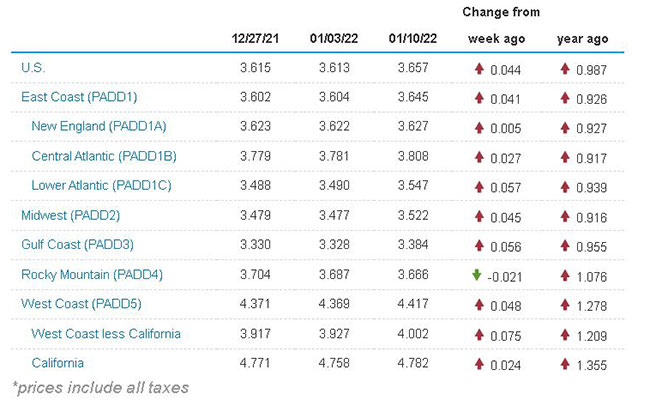Senior Reporter
Diesel Climbs 4.4¢ to $3.657 a Gallon

[Stay on top of transportation news: Get TTNews in your inbox.]
The national average price of diesel shot up 4.4 cents to $3.657 a gallon after seven consecutive declines, according to Energy Information Administration data released Jan. 10.
A gallon of diesel had declined 12.1 cents on average from Nov. 22 to Jan. 3. Trucking’s main fuel now costs 98.7 cents a gallon more than it did at this time in 2021.
Diesel’s cost rose in nine of the 10 regions in EIA’s weekly survey. The biggest increase was 7.5 cents in the West Coast less California. The Gulf Coast and Lower Atlantic also posted gains of at least 5 cents. Only the Rocky Mountain region showed a decline, 2.1 cents.
U.S. On-Highway Diesel Fuel Prices

Gasoline followed diesel's path, rising 1.4 cents to $3.295. A gallon on average costs 97.8 cents more than a year ago.
EIA in its latest Short-Term Energy Outlook noted U.S. diesel prices averaged $3.29 per gallon in 2021, compared with $2.56 in 2020, and forecast an average of $3.33 in 2022 before dipping to $3.27 in 2023.
Gasoline prices are forecast to average $3.06 per gallon this year and $2.81 in 2023.
#TodayInEnergy - EIA expects #gasoline and #diesel prices to fall in 2022 and 2023 as demand growth slows #STEO https://t.co/xs75lsG9tj pic.twitter.com/ken6nwJPjD — EIA (@EIAgov) January 13, 2022
Meanwhile, freight is growing steadily at this point, Steve Latin-Kasper, senior director of market data at NTEA — the Association for the Work Truck Industry, said during a recent online presentation
That is an indication that supply chain disruptions are improving “kind of slow but steady,” he said. “Despite that goods news, we are seeing big changes in terms of annual percent change in the price of diesel, which means as good as life is in terms of shipments increasing and revenue going up, profit margins are getting squeezed, all other things being equal.”
Latin-Kasper said the price of diesel probably won’t peak until the second quarter.

Latin-Kasper
But it is difficult to know what is going to happen with oil production, he said, especially with “Russia’s willingness to sell to the rest of the world as they amass troops on the Ukrainian border and create some additional international political uncertainty that could easily cause the price of oil to go up more than it would have otherwise before reaching a peak and starting to stabilize again.”
American Petroleum Institute CEO Mike Sommers, in an address on the state of American energy, said that in many ways it is strong.
“Our nation has the resources and expertise it takes to meet our energy needs, support millions of jobs, continue to address the risks of climate change and keep America free from the dangers of dependence on unreliable foreign sources,” Somers said. “Even so, we begin 2022 with Americans viewing energy and its costs as major concerns.”

Sommers
API also is partnering with government agencies and across industries to reduce emissions, he said.
The trade group supports the direct regulation of methane from new and existing sources, and is sharing industry knowledge and experience to inform the U.S. Environmental Protection Agency’s expected rulemaking.
API, Somers said, has collaborated on advanced vehicle technologies and cleaner fuels. He noted new cars, trucks, SUVs and buses run 99% cleaner for most tailpipe emissions than models produced in 1970.
“Worldwide, as the need for energy continues to grow, so will the commitment of nations like ours to a lower-carbon future,” he said.
On Jan. 12, West Texas Intermediate crude for February delivery rose $1.42 to settle at $82.64 a barrel in New York. The 52-week range for the product is $49.12 to $83.10.

New year, new resilience. Host Mike Freeze and reporters Connor Wolf and Eugene Mulero uncover the lessons 2020 and 2021 taught trucking's business leaders and consider business and legislative solutions in the year ahead. Hear a snippet above, and get the full program by going to RoadSigns.TTNews.com.
For the week ending Jan. 7, EIA reported distillate fuel inventories (which include diesel) increased by 2.5 million barrels last week and are about 15% below the five-year average for this time of year.
Bloomberg reported oil has been buffeted by wider sentiment in financial markets so far this year.
U.S. consumer prices soared last year by the most in nearly four decades, illustrating red-hot inflation that sets the stage for the start of Federal Reserve interest-rate hikes as soon as March, it wrote.
The consumer price index climbed 7% in 2021, according to Labor Department data released Jan. 12, in line with forecasts.
Earlier, the International Energy Agency said demand is stronger than expected in the wake of the omicron variant while disruptions in major producing countries are pinching supplies.
Meanwhile, EIA reported as of Jan. 7 distillate fuel product supplied (an indicator of demand) averaged 3.8 million barrels a day over the past four weeks, up by 7.3% from the same period last year.
Want more news? Listen to today's daily briefing below or go here for more info:


